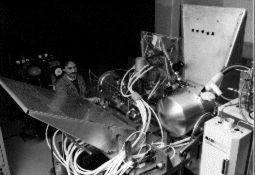RADIO SIGNALS FROM SATURN
 Palo Alto: Late last year, conspiracy theorist Carl Logan of Emmetsburg suggested that NASA's plutonium-powered Cassini Probe was designed in part to investigate radio waves being emitted from or near Saturn (see: Conspiracy in Emmetsburg?, November, 1997: vol. 4, Issue #11). He felt that the probe was the culmination of astrophysicist John O'Leary's work, which began with his discovery of the O'Leary sphere surrounding the Earth.
Palo Alto: Late last year, conspiracy theorist Carl Logan of Emmetsburg suggested that NASA's plutonium-powered Cassini Probe was designed in part to investigate radio waves being emitted from or near Saturn (see: Conspiracy in Emmetsburg?, November, 1997: vol. 4, Issue #11). He felt that the probe was the culmination of astrophysicist John O'Leary's work, which began with his discovery of the O'Leary sphere surrounding the Earth.
There may be some truth to all of this. The William H. Handle Radio Observatory here in Palo Alto County has had its dish pointed at the heavens since the mid-1960's. Typically the project works on reading radio waves emitted by pulsars, but recently the observatory has tuned into Saturn. Much of their data is the same as that collected by other observatories over the past two decades. But spanning the past several weeks, the normally random radio signals has been briefly punctuated by bursts of clearly ordered signals.
Physicist Kenneth Lovely, Director of the Handle Observatory, remains reserved in his judgment, yet some excitement sparkles in his eyes. "No one can be sure what exactly causes the radio waves emitted from celestial bodies," he cautions. "In fact, there could be a wide variety of phenomena that could account for them, such as electromagnetic disturbances in their atmospheres. This seems especially probable for the gas giant planets, whose weather is radically different than that of weather on Earth.

Dr. Kenneth Lovely fine tunes the Willima H. Handle Radio Telescope's aim at Saturn.
"The signal was emitted in pulses," says Dr. Lovely. "Imagine a kind of Morse code, and you'll kind of get the idea. We ran the signal through a variety of tests, and our computers told us what seemed utterly impossible. The signal contained binary code, the simplest of all codes." Here he pauses, primarily for dramatic effect. "The code spelled out how to determine the value of ¼. It described a circle, with information on diameter, radius, circumference---the whole bit! Amazing. The signal didn't last long, but it was there."
This was not the only formula to come from Saturn. Two more signals, both exceedingly brief, were detected. The second described the Pythagorean theorem, while the third and, so far, final transmission gave the formula for the area contained within a cylinder.
While the team is quite obviously thrilled at these discoveries, they are not ready to fully commit to the alien hypothesis yet. There is still the off chance that the signals may have been random, yet interpreted anthropomorphically as being intelligent in design. Also remains the possibility that the team of researchers at Handle have been hoaxed by someone inside or outside the observatory. The team is waiting for conformation from other observatories across the globe. In the meantime, the scientists continue to listen to the sky for more miraculous messages.
Back to this Issue Contents
